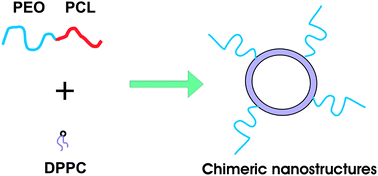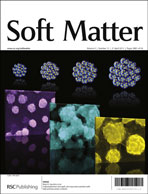PEO-b-PCL–DPPC chimeric nanocarriers: self-assembly aspects in aqueous and biological media and drug incorporation†
Abstract
In this work, we report on the self assembly behavior and stability studies of mixed amphiphilic nanosystems consisting of DPPC (dipalmitoylphosphatidylcholine) and poly(ethylene oxide)-b-poly(ε-caprolactone) (PEO-b-PCL) block copolymer in HPLC-grade water, phosphate buffer saline (PBS) and fetal bovine serum (FBS). These nanosystems are sterically stabilized nanovectors and can be utilized as chimeric advanced Drug Delivery nano Systems (aDDnSs) with stealth properties. A gamut of light scattering techniques (static, dynamic and electrophoretic) and fluorescence spectroscopy were used in order to extract information on the structure, morphology, size, effective charge and internal nanostructure of the nanoassemblies formed, as a function of block copolymer content, as well as temperature and concentration. The incorporation of PEO-b-PCL leads to nanoassemblies of smaller size. All the mixed formulations were found to retain their original physicochemical characteristics for the course of two weeks. The hydrodynamic radii (Rh) of mixed nanosystems decreased in the process of heating up to 50 °C. Gradual degradation of the polymeric chain in an acidic dispersion medium, which leads to gradual structural changes of the chimeric nanovectors, was observed. The micropolarity of the hydrocarbon region of nanocarriers changed significantly in HPLC-grade water and PBS with increasing block copolymer content. The incorporation of indomethacin (IND) led to a decreased size of chimeric nanocarriers. The incorporation efficiency of mixed liposomal–block copolymer formulations for IND was increased in PBS in comparison with the HPLC-grade water, due to electrostatic interactions between the drug molecule and choline headgroups. PEO-b-PCL grafted DPPC liposomes are found to be effective nanocontainers for the encapsulation of IND, especially at the highest molar ratio of the block copolymer.


 Please wait while we load your content...
Please wait while we load your content...